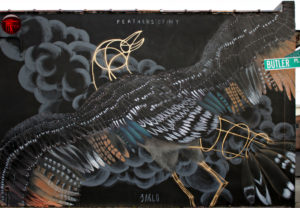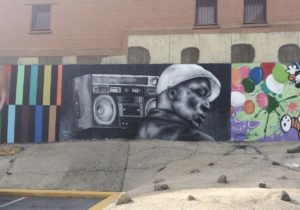With Ken Bollella, all discussions, from the Yankees to the weather, lead back to one subject: cork.
Bollella, the owner of Globus Cork, a flooring factory in the South Bronx, is cork’s biggest booster, and quick to recite a litany of its uses, from sandals to the space shuttle – it’s used as a heat shield in the rocket boosters, according to NASA. It’s also found in gaskets, baseball cores, platform shoes, shuttlecocks and bedding for pet lizards.
Seated on a stool, with long black hair, reading glasses, and a long-sleeve T-shirt, the heavyset 58-year-old entrepreneur looks more like an aging drummer than the cork impresario who heads “the premier U.S. manufacturer of colored cork tiles,” as his website proclaims. He sells cork in 38 colors, and judging by the paint cans strewn across his desk, is concocting more.
Bollella laid out his vision while burning through cigarettes wrapped with a cork-colored filter. As Bollella sees it, cork’s time has come.

Fifteen years ago, Ken Bollella wondered, why does cork tiling only come in beige? Bollella, who now heads a cork painting factory, says, "Nobody's ever done what I do." (Sam Fellman/The Bronx Ink)
Cork, in his estimation, may be the perfect material: light, durable, quiet under foot, resistant to insects and fire, good insulation, and easy on the feet. Bollella, who suffers from severe sciatica, said he can stand on it for hours. And it’s environmentally sustainable.
Cork comes from the bark of cork oak trees grown predominantly in Spain and Portugal. Wine corks are punched out of the bark, with the excess processed into cork sheets. Bollella once made a pilgrimage to a Portuguese forest and watched lumberjacks shear off the bark with axes. Afterward, he touched one of the skinned trees.
“It feels like elephant skin – amazing,” he said with a touch of reverence in his thick Bronxese.
Everything can be corked. Take the yoga mat – wouldn’t that be better with cork? Bollella rummaged behind some boxes and pulled out a large spool, spun with thin cork, the raw material for Korq Yoga and Pilates Mats, based in Brooklyn.
Music, not cork, was Bollella’s original muse. After growing up in Washington Heights, Bollella studied liberal arts at Manhattan Community College, but his main focus was rock guitar. When a rock career didn’t pan out after the better part of a decade, he learned carpentry – “Something had to pay the bills; rock ‘n’ roll wasn’t,” he said – and eventually wound up in flooring.
His cork odyssey began in 1995, when he owned a flooring shop in Manhattan, which sold cork tiles – brown, square, straight-edged and to his mind, boring. So he started dabbling with colors and designs in his apartment. By 2001, when he closed his store, he was ready to launch a colored-cork factory.
To drum up business for his launch, he fixed up his Manhattan apartment with a cork floor of brown mahogany (“Scotchwood,” as he named it) tiles in a herringbone layout, and hosted a wine and cheese party.
“I even got dressed in a suit. I hate suits,” Bollella said. Then the guests began to arrive. Many couldn’t believe what they were seeing.
“People would stare at the floor and say, ‘That’s not cork!’” Bollella said. “Trust me, it’s cork,” he would reply.
At first, no one recognized colored cork. Especially not the competition. At that point, big manufacturers like the Portuguese company Amorim still sold cork tiles exclusively au naturel with a wax finish; in appearance, their products seemed unchanged since cork flooring was invented more than a century ago. So when Bollella’s colored tile hit the market in 2001, it baffled his competitors, who either saw him as a Young Turk or a small-time kook. They even mocked the name of his company – Globus, a combination of the words global and U.S., which Bollella dreamed up over a vodka martini.
“Nobody’s ever done what I do,” Bollella mused for a second, while recalling those heady days. “In the beginning, it’s like I’m sitting on top of a goldmine, without a pick or a shovel.”
Globus Cork opened in 2001, when he rented a large basement on East 136th Street in the Bronx, hired a salesperson, and then set to work. Bollella became a one-man cork tile assembly line, placing orders for processed cork from Portugal, then sawing, painting and shipping it to designers and home owners. He remembers working 105-hour weeks. To avoid the trek back to Manhattan on the really late nights, he’d set up an air mattress on the finishing counter – the floor was always off-limits, he explained, because of all the rats.
Those sacrifices are paying off as his company’s sales rise year after year. Even in 2009, amid a deep downturn in new construction and remodeling, Bollella said his sales grew by 12 percent. He sells his tiles for an average of $7.25 per square foot and expects to sell more than 250,000 square feet this year. Sales are on target so far, he said.
Most of his recent business is institutional. The government of Barbados bought 18,000 square feet of mahogany tiles for a courthouse and the housing authority in Little Rock, Arkansas is remodeling the hallways of a 12-story apartment building with tile, courtesy of stimulus money. While he’s processing the Arkansas order, Bollella is trying to win a contract to floor three galleries at the Metropolitan Museum of Art. But after each sample he’s sent, the museum has replied they want something “grayer.”
Globus Cork has grown over the past three years to occupy large swaths of three buildings. A recent tour of his mostly subterranean empire began at East 136th Street and ended at the loading dock on East 137th Street, spanning an entire block. His company now has three salespeople – one based in Missouri – and a production team of seven. That frees Bollella for chain-smoking and big thinking.
Haiti is his latest idea. After the devastating earthquake in January, the country needs to rebuild everything from government palaces to countless homes, requiring acres upon acres of new flooring. Bollella is avidly following the reconstruction effort, and pointed out that termites are a huge problem in the Caribbean. Of course, he added, “They don’t eat cork.”
Part of his success comes from seeing every situation or exchange as a possibility to push cork. When firefighters, heavy boots on and all, stepped into his cork-tiled office recently on a fire inspection, he asked them how the floor felt. Good, they replied.
Before the firefighters left, Bollella asked them a question that he’d long wondered about, “What’s the worst type of floor?”
One of the firefighters replied, “‘Vinyl – that stuff is nasty,’” Bollella recalled.
Bollella is now designing a new flooring scheme – red tiles with their ladder number inset in marigold – to retile their burnt kitchen floor.
From his vantage point, Bollella sees a flooring arms race mounting around the world. The latest threat is China, namely its bamboo – another environmentally friendly flooring material. Over the last few years, the bamboo trust has spent so much on advertising that “people know more about bamboo than cork,” Bollella said.
His epiphany came a few years ago, while watching the scene from “The Godfather” when the dons of the five warring families gather to air their grievances and leave resolved to bury the hatchet. That is exactly what the corkmongers need to get past all the “my cork is better than yours” infighting, he realized.
So Bollella founded the North American Cork Association three months ago. Although no other companies have contributed to the non-profit yet, Bollella has big plans: cork kiosks in bus stops, billboards, mention in a TV show like “Flip This House,” and ads “just to get people thinking about cork,” he said.
Already, Bollella has sold cork to clients in Canada, Hong Kong, Macau, the United Kingdom, Romania and Australia, where he hopes to open a factory in a few years – to “feed the Japanese market,” he said. So even with renewed competition and a slow economy, Bollella sees cork’s future as bright.
“It’s a perfect time for me. People are a little choosy and green isn’t going to go away,” he said.
“You can’t get greener than [expletive] cork.”





